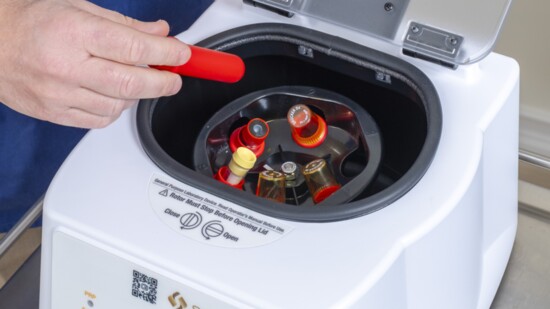In their sun-drenched office with gleaming white walls, Andy Paulson and his wife, Jessie, co-founders of Regenerative Works, sit down with us to chat about platelet-rich plasma therapy, or PRP. Never heard of it? You’re not alone—but what you don’t know might just change your life.
The concept of PRP started in 1970s Europe, with hematologists studying platelets and their role in blood-clotting and wound-healing. Gaining popularity in the 1990s, American athletes would travel to Europe for this non-invasive treatment as an alternative to surgery. In 2009, the FDA began regulating PRP, giving Americans with osteoarthritis, muscle injuries, sports-related injuries, and other chronic pain conditions access to this all-natural therapy.
Andy is a nurse practitioner, but he wasn’t always interested in PRP. He and Jessie met at Boston University, where he studied psychology and she, fine art. “I worked in nonprofits and figured out I didn’t want to be a clinical psychologist. But I liked helping people, so I went back to school for nursing,” Andy tells us. Earning his Masters from the University of Pennsylvania, Andy’s first position as a nurse practitioner was in orthopedics. There, he learned how to perform various types of joint and muscle injections.
“We were just injecting steroids—and over time, that’s detrimental to bone health,” Andy tells us. “Steroid injections [aka cortisone shots] can actually lead to worsening of your arthritis,” he says. “They can also lead to necrosis of the bones.”
Andy wanted a better, safer way to help people who were suffering—one that didn’t involve steroids. So he started researching various PRP treatments with Dr. Mark Thinieur, trying to discover the most effective therapy. “We experimented with different systems and realized that if you use high-quality, highly-concentrated PRP, you don’t need anything else,” he explains.
Conditions that can be treated with PRP include meniscus tears, rotator cuff tears, plantar fasciitis, patellar tendonitis, bursitis, and much more. The best part? PRP uses your own body as a tool for healing. “We aren’t injecting corticosteroids, cortisone, hyaluronic acid, or any other foreign substances that can potentially hurt your cells or damage your bones. We’re putting your own platelets back into your body and giving your immune system a boost,” Andy says.
For such an effective procedure, the entire process is rather simple. First, Andy draws about 15 milliliters of blood. The vials go into a centrifuge, spinning at a rate of 3,500 revolutions per minute. In under ten minutes, the platelets are isolated, leaving 3-4 milliliters of “liquid gold”—plasma, the liquid portion of our blood, plus platelets, a type of blood cell that plays an important role in healing. This solution is drawn up into a syringe, then injected into the target area.
“When you get injured, first white blood cells flood the area, then platelets, then growth factors,” Andy explains. “If you have a chronic injury, the body has already done what it can to heal. PRP triggers the immune response again, which sends more white blood cells, platelets, and growth factors. These work together to heal the damaged tissue, muscle, or bone,” he says. From start to finish, the procedure takes just over an hour—but can relieve pain for up to two years.
One of Andy’s most rewarding cases—and a big reason why Regenerative Works exists—is Jessie’s father. “My dad was told that if he wanted to continue hiking, he needed surgery for meniscus repair in both knees. Andy did PRP for him, and he’s never had to have surgery. He’s hiked Machu Picchu with my younger sister, Iceland with me, and just traveled with my older sister from Portugal into Spain, hiking 14 miles a day. He is living proof of the benefits of PRP,” Jessie tells us.
PRP is not limited to healing—it can also be preventative. It can slow down, or even stop cartilage damage. “The amount of people we’ve helped that way is immense. Our goal is to make PRP even more accessible to more people,” Andy says.
Visit regenerativeworksct.com to learn more.
If you have a chronic injury, the body has already done what it can to heal. PRP triggers the immune response again, which sends more white blood cells, platelets, and growth factors. These work together to heal the damaged tissue, muscle, or bone.
